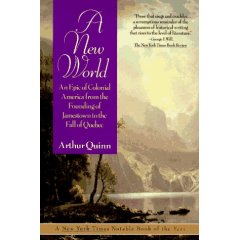Books I Love: “A New World”
 (This is part of an ongoing series introducing you to books I’ve loved, with explanations why.)
(This is part of an ongoing series introducing you to books I’ve loved, with explanations why.)
Anyone who went to an American public school already knows the names: John Smith, William Bradford, William Penn, Benjamin Franklin, George Washington, and all the other men (and they were, alas, all men) whose labors resulted in the transplanting of Old Europe on a new continent.
So why bother telling the stories again, when every schoolchild has already heard them?
In “A New World”, Arthur Quinn shows why.
“A New World” is history as storytelling — Quinn’s prose crackles with life, and he brings a forcefulness and vividness to his depictions that you usually don’t find in works of history. Each time he turns his attention to a person, you come away with an understanding not just of what that person did, but why they did it.
His method for providing this understanding is to structure his book as a series of personal narratives, each focusing on a single individual, and each told from that individual’s perspective. Quinn doesn’t tell his stories in the first person, but each portrait so clearly identifies with the perspective of its subject that you find yourself seeing the world through their eyes.
Take, for example, the story with which he opens the book — that of Captain John Smith, founder of the first permanent European settlement in North America, Virginia’s Jamestown Colony. Most Americans today probably know Smith because of his purported romance with the Powhatan princess Pocahontas, thanks to generations of bad textbooks and a Disney movie. Quinn demolishes the myth that Smith had any concern for Pocahontas in short order, and moves on to his primary narrative: John Smith as killing machine.
Smith, you see, was (like most of us) a product of his times; and those times were terribly, terribly violent. Europe had been wracked by war for generations — Smith was born twenty years into the Eighty Years’ War, and in his early years he was swept up in the violence, fighting the Spanish and managing to get himself captured by the infidel Turks for a period. By the time he came to America in 1607, Smith had two stars by which he set his course: a bone-deep conviction of the value of ruthless violence, and a single-minded dedication to the promotion and greater glory of John Smith. In America, he would have the chance to give free reign to both of these.
Quinn captures this brilliantly in a brief passage exploring the irony that Smith, a man of action and violence, would be remembered by history primarily because (good self-promoter that he was) he took the time to write up his memoirs and circulate them in England — memoirs that argued that the Virginia colony had become dangerously soft, choosing to live alongside the Indians instead of driving pitilessly to exterminate them. When the Indians rose up in 1622, killing one third of Virginia’s colonists in their beds in a desperate bid to drive the Europeans out once and for all, Smith’s words established him as a seer — a hard man for hard times. He would never return to Virginia, but his policy prescriptions were taken up after the revolt, with devastating effect on the Indian population.
Of Smith, Quinn writes that
his literary achievement was considerable. No one, not even Christopher Marlowe, expressed better the grasping, insatiable spirit of the Renaissance. Smith’s undying achievement is himself, captured for us forever in his words, like some huge predatory insect frozen hideously at the moment of the pounce, mandibles eternally agape.
Quinn’s Smith is a character out of a horror movie, not a Disney movie.
And yet, despite this, you find yourself understanding why Smith was so brutal, why he put his faith in cold steel and hard hearts. Smith saw himself in a world where danger lurked from all corners: Virginia was a garden of death, with exotic new diseases slaying colonists left and right, starvation always lurking around a corner, and a strange people, armed and uneasy, living just over the next hill; and the Europe in which Smith grew to manhood was a continent that had been riven by brutal religious wars for literally his entire life. You find yourself examining Smith in the same way you might examine a picture of a shark — marveling at its rows of teeth and its sublime adaptation to its surroundings, even as you pray you never encounter such a creature outside of books.
Quinn brings the same deep insight and beautiful writing to each of his portraits, each of which moves forward the story of the conquest of America. From Smith, he moves to Samuel de Champlain, French explorer and founder of Quebec; William Bradford and the voyage of the Pilgrims, begun in joy and concluded in disillusionment; John Winthrop, shrewd governor of Massachusetts Colony; and many others, his narrative concluding as the English conquer New France and the stage is set for the American Revolution.
Some of Quinn’s subjects are historical giants; others are men scarcely noted by history. But each is a fascinating human story, and you will not realize until you have finished the book that it is more than that, more than the sum of its parts; that it has opened to you a sweeping new perspective on the earliest days of America.
If you like history, you’ll enjoy “A New World”; but if you don’t like history, I think you’ll enjoy it even more. It is history that rivals the best fiction in color and intensity. It is history that lives and breathes.
